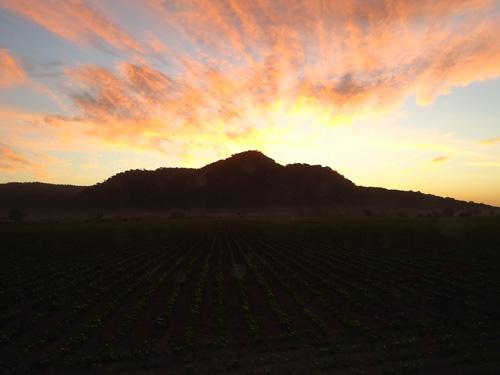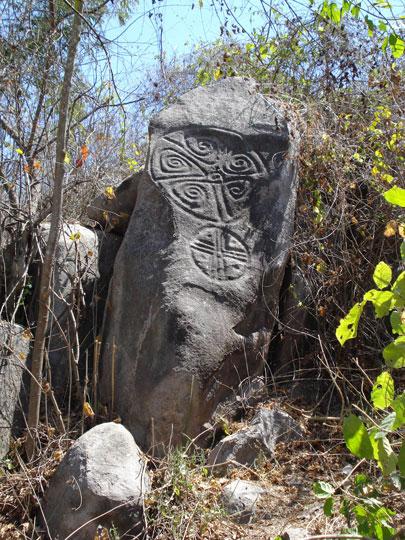Aztatlan Astronomical Observatory linked to sun worship
Source - http://www.pasthorizonspr.com/index.php/archives/02/2014/aztatlan-astronomical-observatory-linked-to-sun-worship
Photos: Mauricio Garduño / INAH
CERRO DE COAMILES, EMBLEMÁTICO ESPACIO RITUAL DE LA CULTURA AZTATLÁN
Source - http://www.inah.gob.mx/boletines/17-arqueologia/7039-cerro-de-coamiles-emblematico-espacio-ritual-de-la-cultura-aztatlan

Aparición del disco solar sobre el perfil orográfico del Cerro de Coamiles, durante el equinoccio de primavera. Foto: Mauricio Garduño-INAH.
Archaeologists have located an astronomical observatory linked to sun worship in the Cerro de Coamiles site, one of the leading centres of Aztatlán (AD 850/900-1350 ) culture located in the central coast of Nayarit, Western Mexico. This discovery has helped define the importance astronomy had for the coastal boreal Mesoamerican.
Mauricio Garduño Ambriz, an archaeologist at the National Institute of Anthropology and History (INAH), said the observatory forms part of a ritual architectural complex which was built to record the passage of the sun through the sky at the equinoxes. Within the Mesoamerican religious tradition, mountains or step pyramids were conceptualised as solar temples.
A sacred space
The results of this investigation represents a significant advancement in the understanding of the symbolism employed in Aztatlán ceremonial architecture which was linked to the solar calendar and the annual ritual cycle connected to agriculture. Research in the Cerro de Coamiles began in 2005 and is still continuing, concentrating on the upper platforms located on the southwest side of the hill where a tiered system of large embankments forming part of the main ceremonial centre has been discovered.

Retaining walls of the first two stages of the Plataform 4. Early Postclassic (Cerritos phase, AD 900-1100).

North Acropolis (Platform 5). Front steps of the first two construction phases of Mound 3. I
The inhabitants of Cerro de Coamiles modified the top part of the hill, cutting into natural rocky outcrops to form vertical terrace lines which worked as solar calendrical markers. Garduño Ambriz explained that “the solar disc would appear in direct view from the main observation point on the North Acropolis hill, creating a visual line from west to east. Recording the appearance of the solar disc on the eastern horizon at the equinoxes defined the space as sacred.”
Solar God Xipe Totec

Solar God Xipe Totec
The symbolic importance of marking equinoxes in coastal Aztatlán is confirmed by the frequent sculptural representation of Xipe Totec (flayed one), the sun god associated with spring equinox and his depiction on ceramic vessels intended for ritual purposes.
“For the dense population of the surrounding flood plain that stretched all the way west to the shore, Coamiles must have represented a mythical archetype within the regional symbolic scenery,” said the archaeologist.
Platform 4

Cerro de Coamiles. Se aprecia la nivelación monumental (Plataforma 4), en su parte media.
Excavations have also been conducted at Platform 4, a large square space constructed for ceremonial use, 150 metres in length, where four parallel retaining walls reaching a height of almost three metres correspond to four constructional phases. The peak of this construction took place during the Postclassic.
Garduño Ambriz said that “the coordination and execution of this monumental work of remodelling, which significantly altered the original topography of Cerro de Coamiles even appears on the 18th century mapping of the plains of Yscuintla and Senticpac.”
“This would have required centralised political institutions and mechanisms of ideological control by the social elite of local and regional hierarchies of Aztatlán society. Apparently, the peak in Coamiles constructional activity matches panregional territorial reorganisation that took place during the Early and Middle Postclassic (AD 900-1350 ).”

Vertical stele with astronomical petroglyhs.
The director of the Nayarit INAH Centre, Othon Yaroslav Quiroga Garcia, said that given its location within the central coast of Nayarit, as well as the exceptional state of preservation including ceremonial public architecture, petroglyphs and a wide range of flora and fauna, the site would be considered for opening to the public in the future.